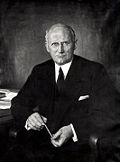 | |
 | |
 | |
| Agency overview | |
|---|---|
| Formed | 26 May 1922 |
| Dissolved | 14 June 1930 |
| Superseding agency | |
The Federal Narcotics Control Board (FNCB) was a Prohibition era senior level law enforcement-related organization established by the United States Congress as part of the Narcotic Drugs Import and Export Act on 26 May 1922. [1] [2] The Board was composed of the Secretaries of State, Treasury, and Commerce. [3]
Contents
The duties of the board were;
- To prohibit opium imports for other than medical purposes
- To limit exports to nations with an adequate licensing system [4]
The duties of the board were further amended;
- To outlaw the manufacture of heroin in the U.S. [4]
Congressional leadership in narcotics control was handled by Steven G. Porter, chairman of the House Committee on Foreign Affairs. [4]
The duties of the board were transferred to the Commissioner of the Federal Bureau of Narcotics on 14 June 1930. [5]











